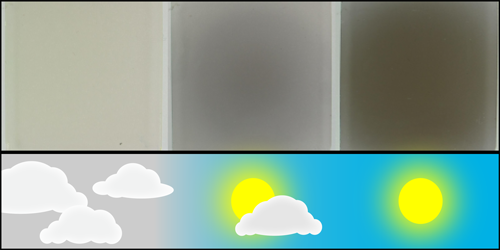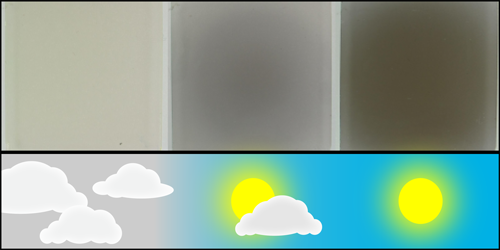“Breathing” Explains Light-Induced Darkening
Several materials go through a reversible change in color or transparency when exposed to light. This so-called photochromism is commonly used to make sunglasses that darken in sunlight. In 2011, scientists discovered photochromism in the rare-earth-containing material yttrium oxyhydride (YHO), but the mechanism behind this specific example of light-induced darkening remained hidden. Now, José Montero from Uppsala University, Sweden, and colleagues show that YHO “breathes” out oxygen under illumination, causing it to change from transparent to black.
Photochromism has long been known to occur in silver halides and certain organic dyes. Silver halides, which are often used in photochromatic eyeglasses, owe their light response to photon-liberated electrons combining with silver ions. This electron-based mechanism does not account for the photochromism in YHO, so several research teams have sought other explanations.
Montero and colleagues hit upon their breathing mechanism while studying YHO films under both air and nitrogen gas environments. Surprisingly, the films bleached in air but remained dark in nitrogen. In addition, they found that the films became more hydrophobic under light exposure—whereas other metallic compounds become more hydrophilic. In piecing this puzzle together, the team realized that light caused a small fraction of oxygen atoms to diffuse out of the YHO crystal lattice—as they confirmed with x-ray spectroscopy. The resulting oxygen-depleted regions absorb light, explaining YHO’s light-induced darkening. The process reverses when the lights go off—and oxygen is re-absorbed by the material.
For photochromatic applications, YHO is more robust than organic dyes and more compatible with glass-glazing technologies than silver halides. For this reason, Montero and colleagues foresee using YHO films on “smart” windows that change color depending on the weather outside.
This research is published in Physical Review Materials.
–Michael Schirber
Michael Schirber is a Corresponding Editor for Physics based in Lyon, France.





